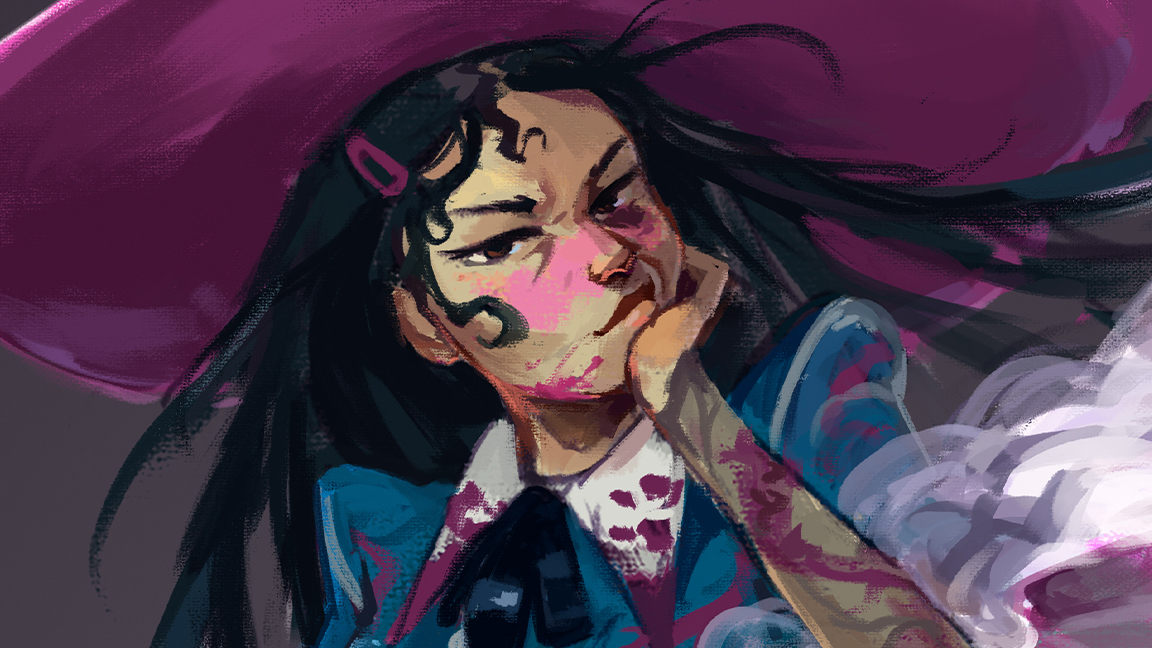
My video game concept art tutorial will reveal how to reuse old photo reference you've discarded to create something new and inventive. This tutorial was inspired by a visit to the Legion of Honor museum in San Francisco. I was not prepared for the abject beauty and craftsmanship on display at Guo Pei's Couture Fantasy exhibition. So much so that I spent three hours moving from dress to suit to wearable sculpture, drawing frantically until my iPad battery died.
I wanted to do a fully fledged illustration inspired by what I'd seen, but crucially though: they weren't my designs. However, it wasn't like I was lacking in reference. One tumble into my Google Photos led to a wealth of potential directions that came with lived personal experience, I just needed a solid shove to actually use them. (This tutorial uses Photoshop, read our Photoshop tutorials roundup for similar training.)
I'll go through how I picked out my inspiration and developed a backstory, my painting process
In this tutorial I'll be going through my thinking and painting process for Midsummer Tourney of the Well, which was directly inspired by one of Guo Pei's incredible designs. I'll go through how I picked out my inspiration and developed a backstory, my painting process, and also some of the mistakes I made along the way!
If you have a study you'd love to jump from into a world-building project, or an overflowing camera roll of Things Your Swear You'd Paint Later (and I know you do), consider this tutorial a draw-along to get you going! I'll be using Photoshop - not for any particular reason except familiarity. Begone blank canvases, let's start making some interesting new paintings!
Video game concept art tutorial: using photo reference
01. Identifying what most excites you
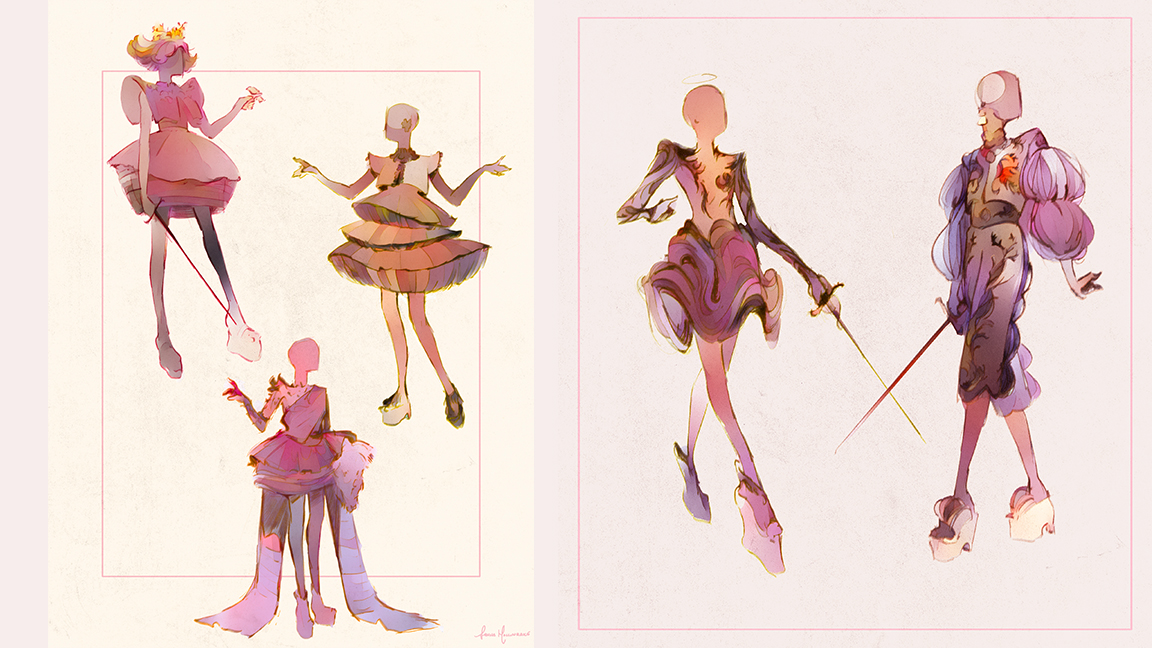
At the Couture Fantasy exhibit I drew sword girls. Sword girl after sword girl. This makes this step relatively easy for me; I want to take a high-fashion sword girl design further into a full illustration, but also making sure I’m making something new.
If you don't have as clear an idea, for example if your study is of a landscape or loose sketch, try to think about what might be challenging or unusual to mashup with other reference.
(Anna used an iPad to sketch her early inspirations, read our tutorial: digital plein air painting for more advice, and take a look at our Apple Prime Day deals hub for the latest offers.)
02. Adding contrasting themes
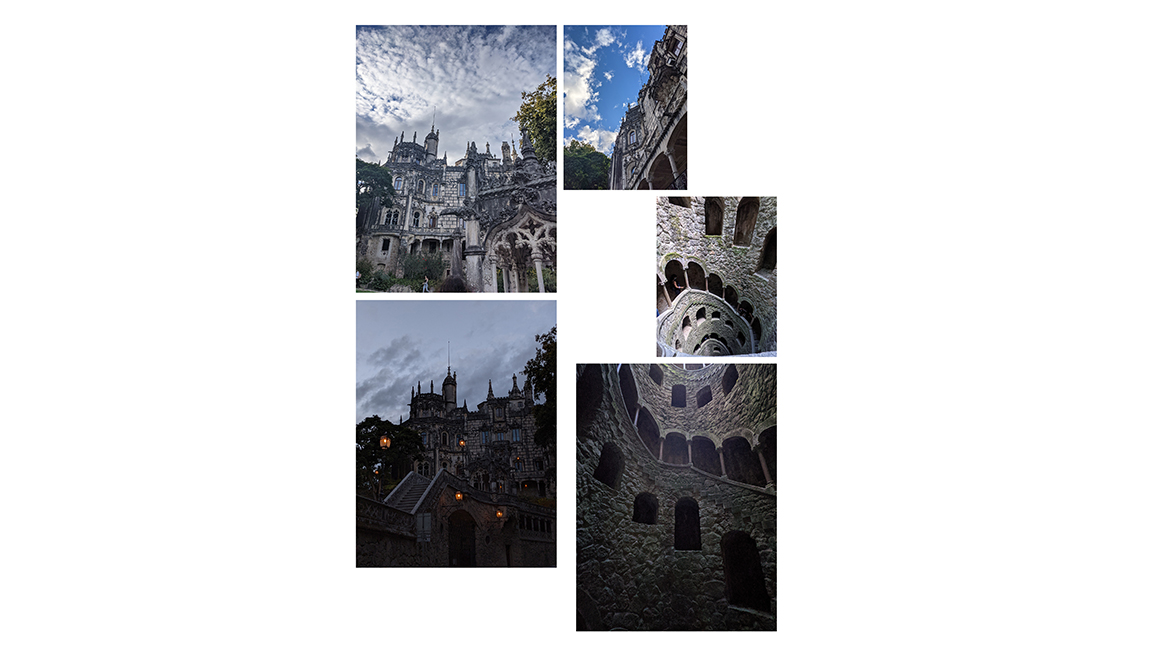
If I'm working from a character, I'll usually look for an environment I've visited to spark some ideas, and vice versa. I tend to keep my moodboards more pared back nowadays to avoid my clarity of vision getting muddied, so I try to find a specific location to contrast with my sketches.
The outfit I'm working from is very light, airy and clean, so I start with thinking about adding some grit to the high fantasy look. I particularly loved the cropped jacket and trousers that could almost have been from a uniform, and I stumble upon my photos from Sintra, Portugal, where I visited the Quinta da Regaleira. It's a beautiful gothic castle that has a weathered fairytale look to it, but also features a garden full of strange sculptures and a foreboding spiral of carved steps that leads deep into the ground called the Initiation Well.
This gets me thinking about a wealthy finishing school with beautiful uniforms but a dark secret; dangerous duels that happen in murky chambers deep underground.
03. Sketching whilst thinking about your character
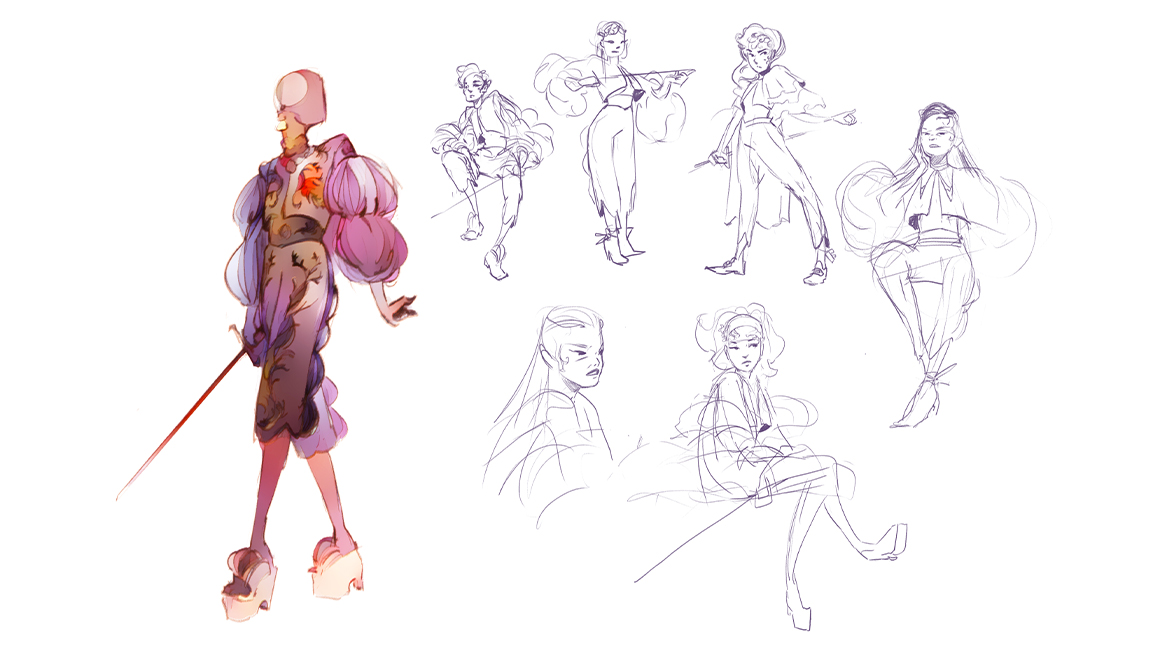
It can be very easy when approaching a fashion-based piece to not think about character portrayal and instead just pour lots of effort into costumes. I want to avoid this, so I start sketching some potential characters with dynamic poses and expressions.
I’ve long accepted I’m just not a silhouette person; I both think in line and prefer to be a bit more playful with who my characters are early on. I initially start quite close to the reference, and then gradually branch out.
Another thing I think about is how these characters might know each other, and who would be friends (and who wouldn't). I end up choosing a girl with long dark hair and a malicious glint in her eye as my character to develop. I think there's something very fun in creating a haughty, Mean Girls-esque Regina George type at the school.
04. Refining the sketch
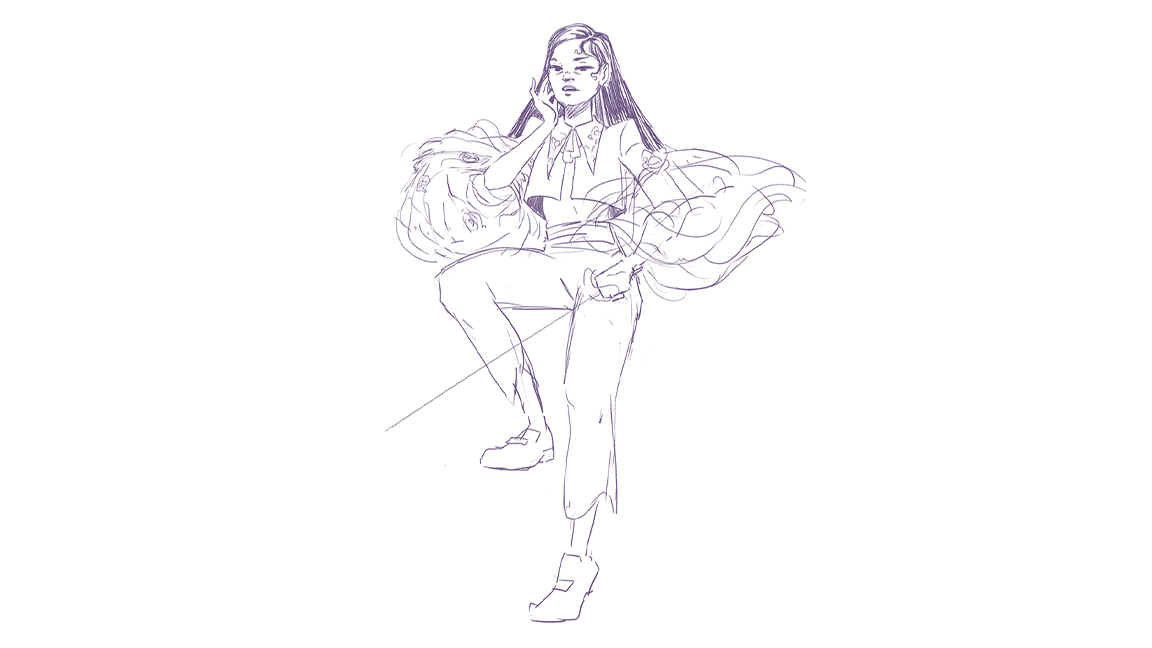
I want to focus on what the main features of this Regina-George-but-with-a-sword character is, so I take a piece a little further. Not much further, mind, but I think about her facial expression and some of her costume details a little more. As I’m doing this I’ll be making up a story in my mind about her; how she talks to people, how she feels about duelling.
Whilst they don’t necessarily feed into the image, it helps me build out an image of her in my mind, and I find it’s easier to solve costuming problems here than in the 'final' image. This is something I have a very bad habit of doing because it seems easier in the moment; this is almost never the case.
05. Starting to paint
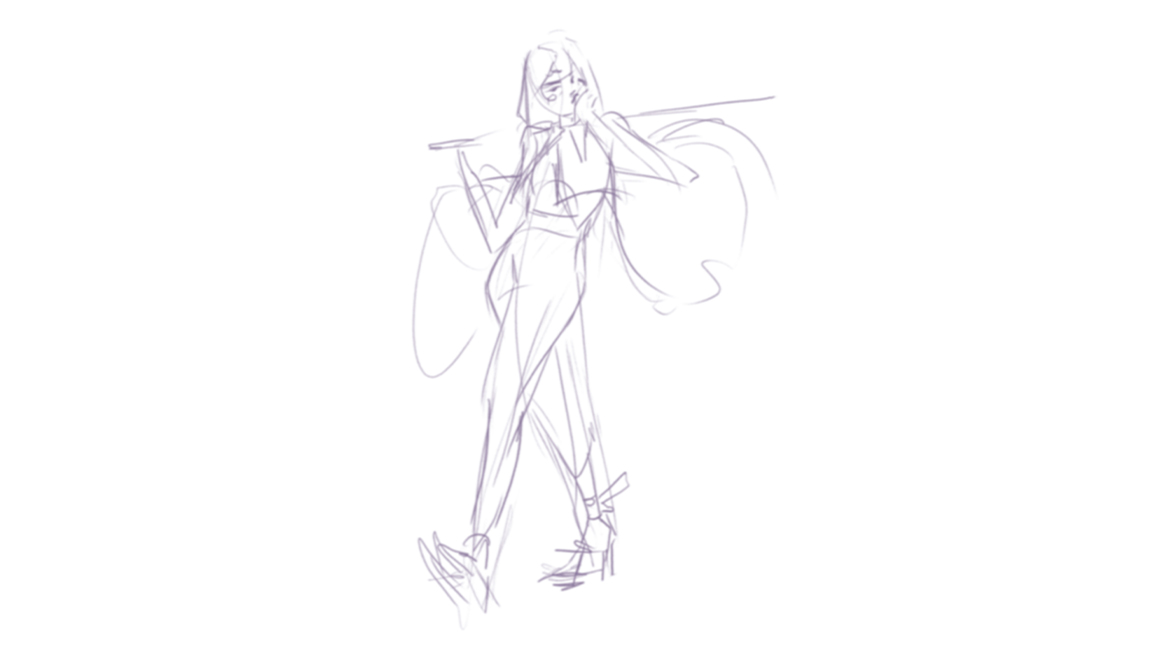
Now that I have my character, I want to tell a story with her movement. I want to reference the runway strut I saw in a lot of the mannequins into her pose, but I want it to be threatening and confident. I try to capture the in-between point of movement rather than at the beginning or the end as it feels less static, and I'll often act out the movement myself to get a feeling of where the weight of the character should be.
With this piece, I liked the idea of her striding toward the camera after a fight, pushing her jaw back into place. Is she gearing up for her next challenge? Is she swaggering away from her latest battle? Either way, I start with a sweeping line of movement and build my sketch from there.
06. Blocking out your shapes
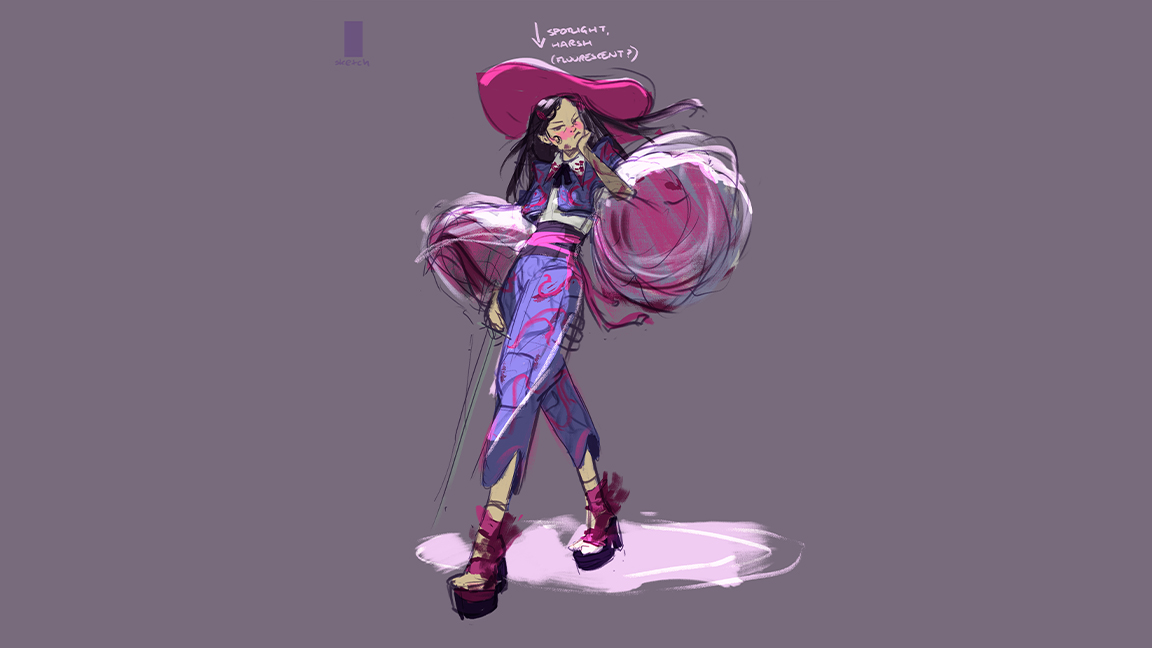
After adding in the costuming elements, I go to colour immediately because working in greyscale isn't very fun or interesting to me, no matter how hard I try. When I do this, however, I try to make a conscious decision to think about my lighting early on so that it’s not just an afterthought, or ends up looking muddy and flat.
I also feel like her head is getting lost, so I add a hat to balance out the shapes. I'm not entirely sold on it yet but it helps draw the eye directly to the face rather than getting caught in the sleeves.
It's worthwhile making a checklist for yourself when preparing to jump into the painting phase of an image: have you decided on lighting? Have you got a rough idea of your colour palette? Are you happy with your silhouette?
07. Putting a background in early
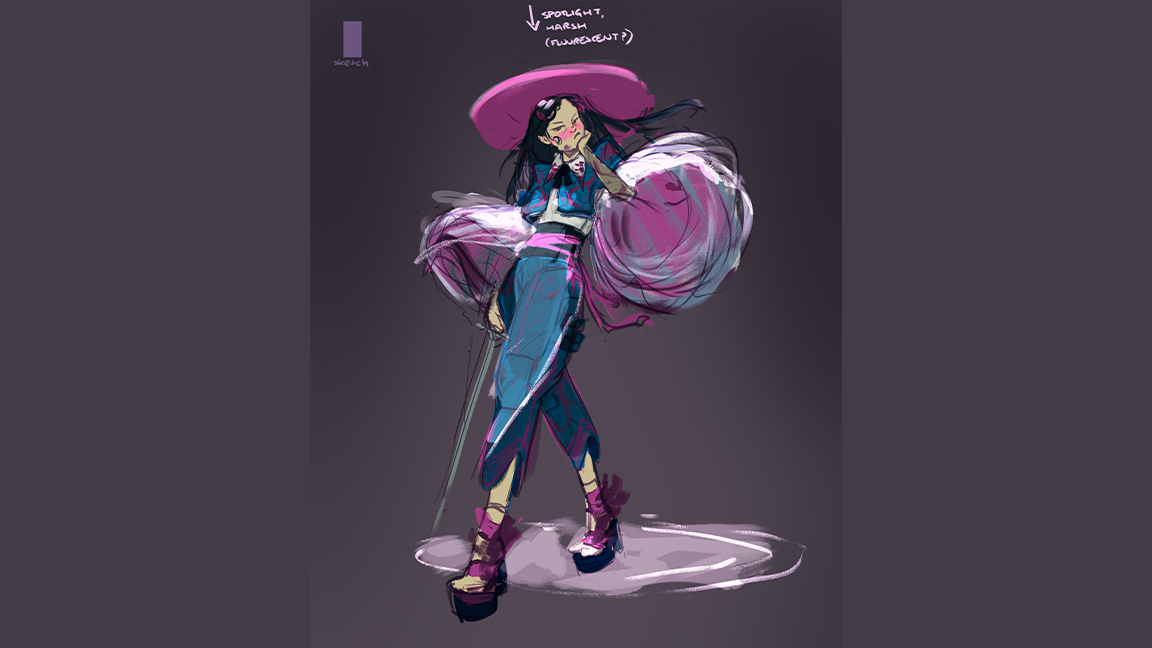
When doing character illustration it is so easy to just ignore the background as an afterthought, but I really encourage you to have it in the back of your mind. (Read our guide to character design tips for more advice.) I want to capture a dingy chamber underground with harsh overhead lighting, so it's hardly complex.
However, even if it’s just some quick shapes and gradients, it will feel a bit more tangible than a flat colour and can help with your thought process. Also, don’t be afraid to simplify. Over-detailing can be such a problem and designs are rarely ever sold by just painting in increasingly more granular detail. Whilst I liked the idea of having brocade embroidery on the trousers and jacket, I was finding that the patterns were really competing with the sleeves
and face.
08. Thinking about expression

I am the most guilty of drawing blank-faced, middle-distance-staring characters. They have no thoughts. However, that doesn’t make for as compelling an image, especially when we’re trying to give our character some bite!
Don’t be afraid to twist their expressions and play with angles; it makes for interesting art! I decided to really push her sneer into something a bit unflattering; it gives her much more personality.
09. Getting more references when needed
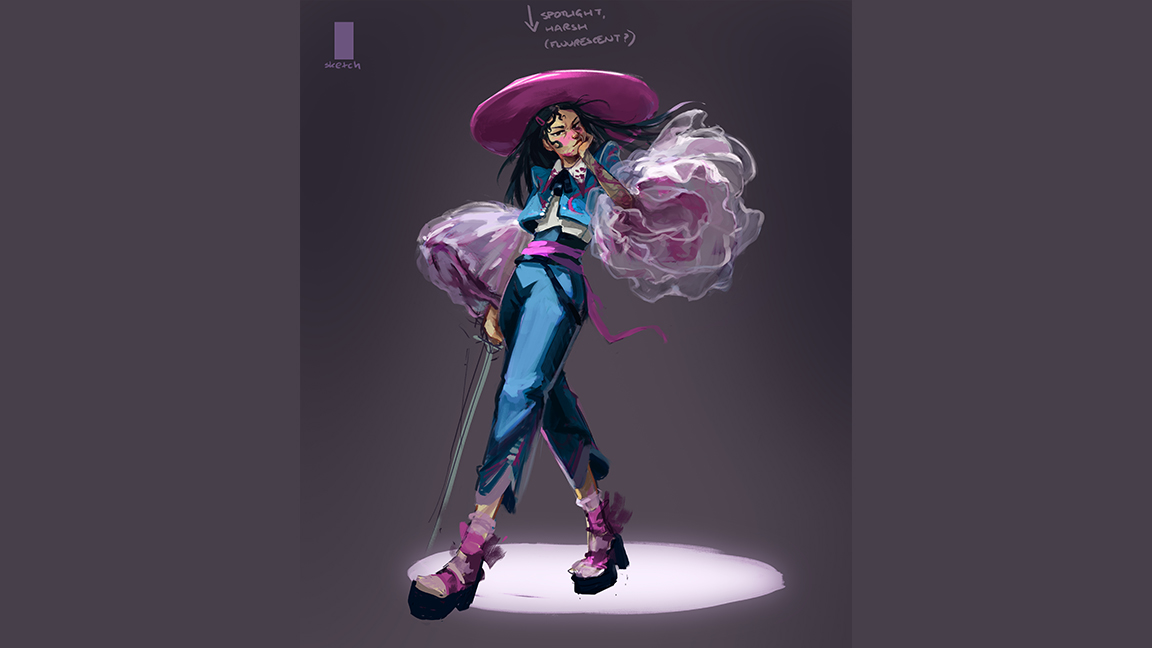
I’ve never painted tulle before, so this became an amazing opportunity to do a mini study. I found that it was much more opaque at the edges, and creased in almost gravity defying ways much more than I anticipated.
Don’t try to brute force your way through figuring out how a material, expression or atmospheric effect looks when you can just Google it. (I'm saying this to myself as well.)
10. Try being your own reference
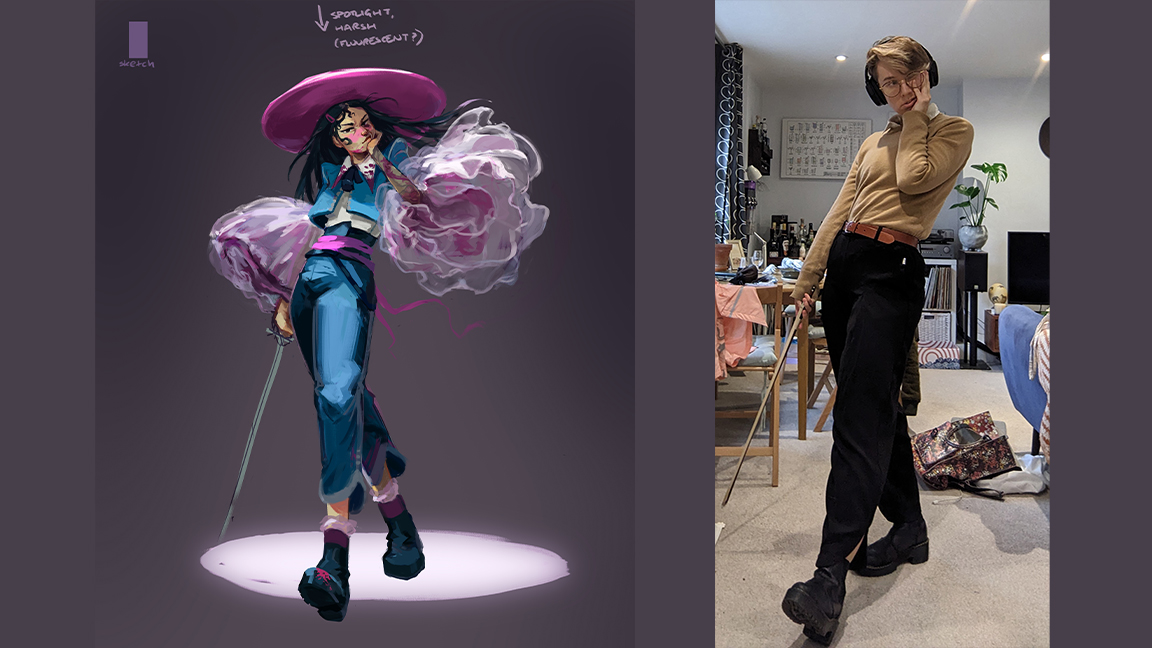
I could not for the life of me figure out this front leg and foot moving toward the camera in a foreshortened perspective, redrawing it multiple times over. I was also finding that the very detailed heel was just far too complicated and was competing with the rest of the image in regards to contrast and visual detail.
I also acknowledge that whilst this was a fantastical finishing school, having extremely complex heels be part of the uniform challenged my suspension of disbelief and eventually I looked for some inspiration close to home, taking a photo of myself wearing my platform Doc Martens and holding my violin bow.
This really helped! Whenever possible, get in front of your mirror or phone camera and enjoy feeling extremely silly as you do it. You’re an artist. That's the point. (Read our tips for using photo reference, for more advice.)
11. Trying to solve new design problems off-image
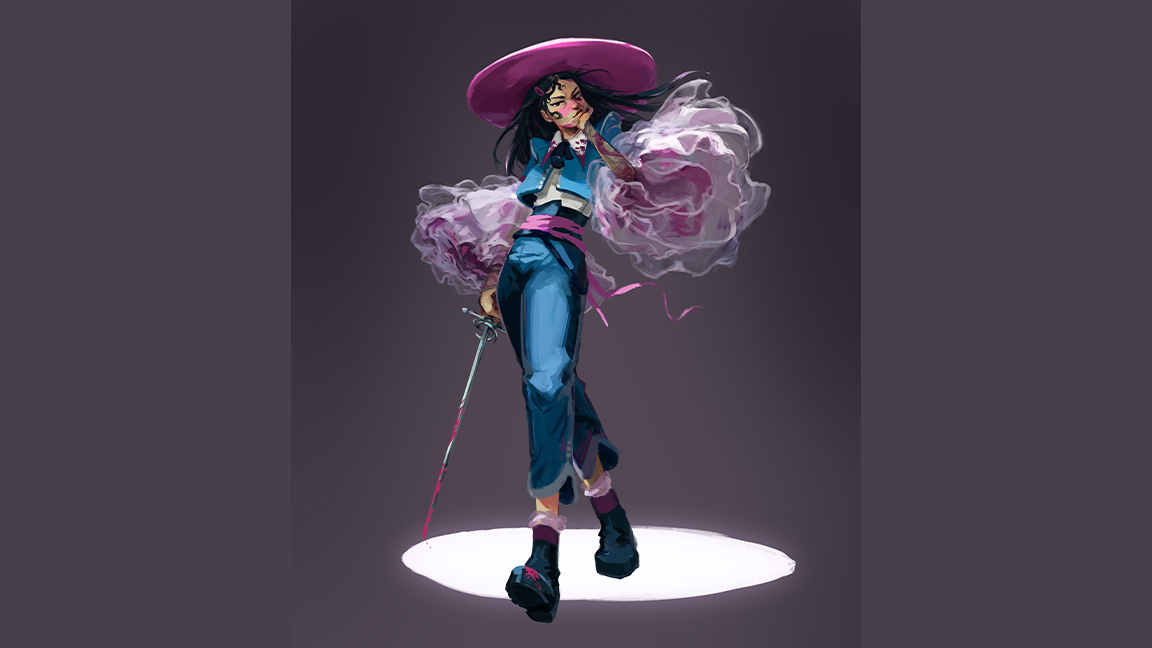
As I mentioned earlier, when possible, solve design problems away from your main image. I didn't have a clear idea of the look of the sword: no sketch, no reference. I ended up noodling and painting over it multiple times, which was a bit dumb and a waste of time. Don’t be me! A Biro sketch in a lined notebook is better.
In addition, I do also think I could have taken the sword further. I love adding personalisation to accessories, and even though it's a weapon, it's a weapon that belongs to someone at a school.
It feels almost certain to me that the students would customise things, like adding charms (however impractical) or colourful grips. Another vote for sketching designs in advance rather than trying to just get something there.
12. Telling a story with the background
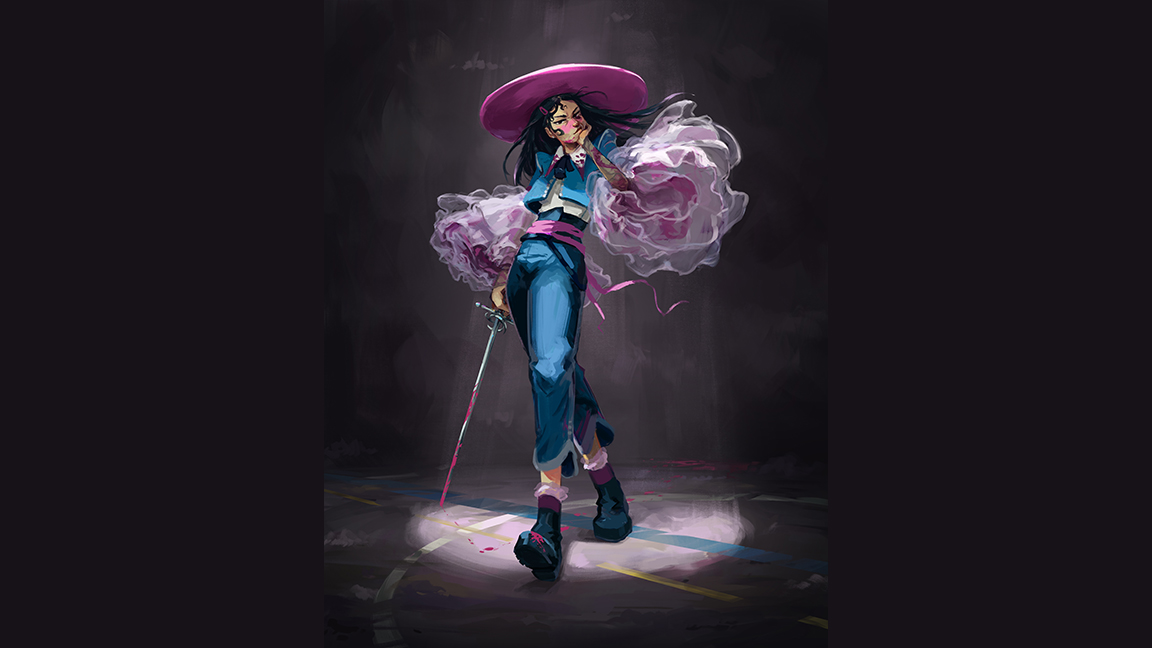
Now for painting the background. I'm drawing upon the textures in my reference here - dark, weathered stone, dust. As you might have guessed from the title, I've imagined that these duels take place at the bottom of a well (that could also be an explanation for the circle of light, I suppose), so I keep things simple and murky.
However, I want to suggest a bit of formality to these duels by putting markings on the floor. There's a sinister implication there that this has been happening for long time - what has happened here in the past? Have people died? It doesn't hurt that the diagonal lines and circular sweeps add a bit of depth to the scene, too!
13. Harmonising everything in the image
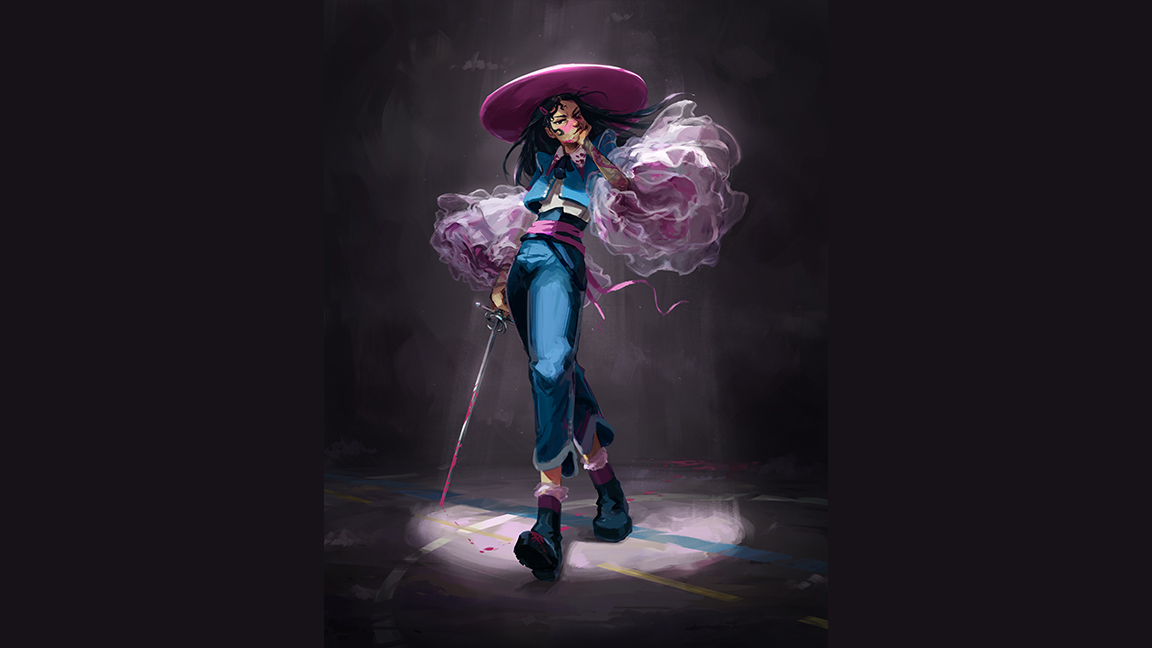
To tie everything together I increased the darkness of shadow on the face and body to match the overhead lighting, and put some shadow on the tulle that fell outside of the spotlight.
After looking at an image for a long time you can become desensitised to contrast and saturation, so it's worth checking your values, flipping your canvas, and looking at the painting on different screens. Concentrate on your main focal points, however, I wanted more of the face to be in shadow so that the part in the light would pop. Don’t crank up the contrast and saturation on everything; it’s okay to let lower priority parts have lost edges or similar values.
In addition, think about the mood and tone you're trying to set. I wanted to make the air feel heavy and dusty, they are in a cavern after all. I added in some haze that caused bloom on the hat and tops of the sleeves, as well as some dust motes catching the light, plus a bit more of a dark vignette around the character.
14. Finally, stepping away and looking with fresh eyes
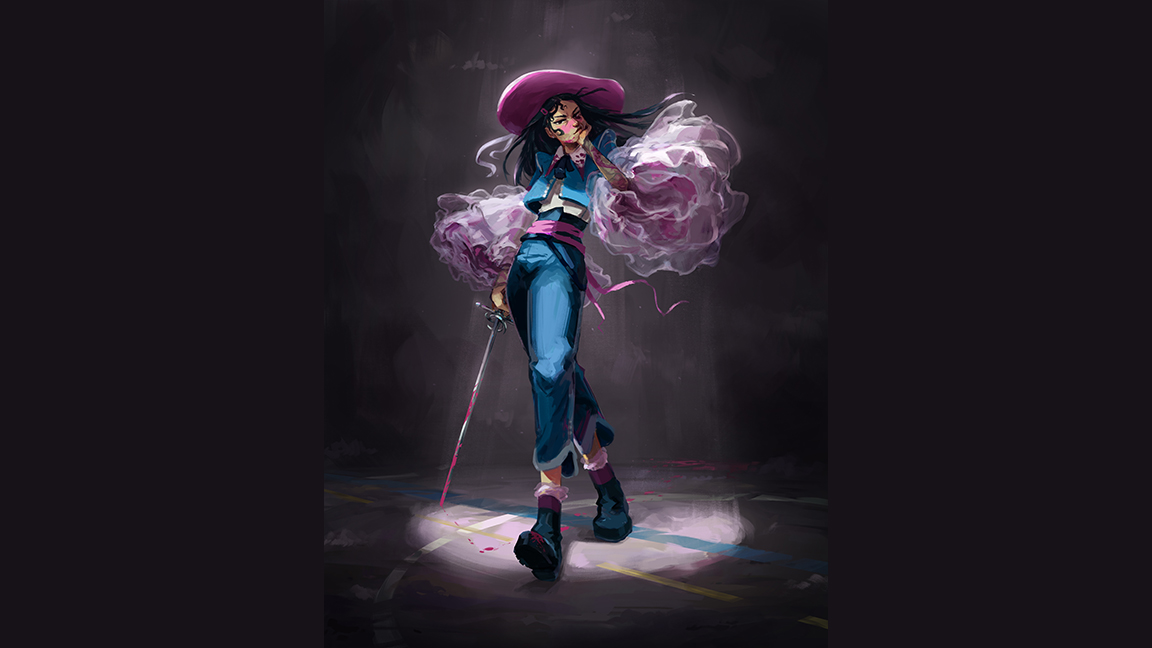
The marination pass, or, just let your painting sit for a day or two before you decide it's done. I’m a big believer in spending an extra 30 minutes polishing up a painting after you’ve slept on it, because your fresh eyes tend to forgive overcritical 1am thoughts, or notice obvious errors that you were too busy to notice.
For me, I really didn’t like the size and stiffness of the hat, and wanted something that felt in keeping with the rapier sword design, like a musketeer. I reduced it down and added a ribbon for a little more movement, and I think it sits together better now!







